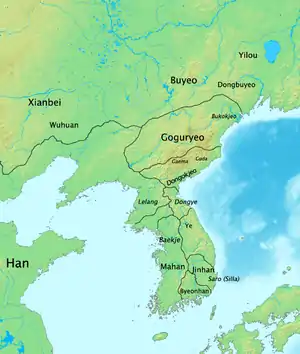Yilou
Yilou is the modern Chinese name of a people in 3rd- to 6th-century Manchuria.
| Yilou | |
|---|---|
 | |
| Chinese name | |
| Traditional Chinese | 挹婁 |
| Hanyu Pinyin | Yìlóu |
| Baxter–Sagart (2014) | */qip-[r]o/ |
| Korean name | |
| Hangul | 읍루 |
| Revised Romanization | Eumnu |
| McCune–Reischauer | Ŭmnu |
| Alternative names | |||||||||||
|---|---|---|---|---|---|---|---|---|---|---|---|
| Sushen | |||||||||||
| Traditional Chinese | 肅愼 | ||||||||||
| Simplified Chinese | 肃慎 | ||||||||||
| |||||||||||
In some sources, their name was also written as Sushen, after an earlier people that were traditionally thought to be from the same region. Although it is common to link the Yilou to the earlier Sushen or the later Mohe (and hence to the Jurchens who founded the Jin Dynasty and the Manchus who founded the Qing), such connections remain unclear, and the groups may even be from different regions entirely. Some historians think that the Chinese, having heard that the Yilou paid arrows as tribute, simply linked them with the Sushen based on ancient records recording a similar practice.[1]
The Yilou paid tribute several times, pleasing the rulers of northern China. According to the 3rd-century classical Chinese text Records of the Three Kingdoms, they were subjects of Buyeo from Han times until a successful rebellion in the 3rd century.
The Yilou disappeared from documents in the 6th century. The Mohe rose into power there instead.[2]
Accounts by outsiders
The Records of the Three Kingdoms records that the Yilou were located more than a thousand li[3] north of Buyeo in forests covering mountainous terrain that had formerly been the kingdom of the Sushen clan. The text reports that, although the Yilou were subjects of Buyeo, they did not speak the same language as the people of Buyeo and Goryeo. The text's author did not know the northern extent of Yilou territory, but they reportedly had access to the sea, as they sailed in boats to plunder other kingdoms. The text notes that the Yilou were the most undisciplined of the Eastern Barbarians, as they were the only ones not to use sacrifical vessels for food and drink.[4]
According to the Records of the Three Kingdoms, the Yilou had access to grain, cattle, horses, and sackcloth, and they produced red jade and good-quality sable skins, for which they were well known. The Yilou were talented archers and had a tendency to poison their arrowtips so that anyone they hit with their arrows died. They raised pigs for food and clothing, and they smeared themselves with pig fat in winter to protect themselves from the cold. Settlements were centred around pig pens, and homes were typically pit houses, with those of the wealthy families descending as far as nine steps below ground. They apparently had no single ruler; instead, each settlement had its own head (Chinese: 大人; pinyin: dàren).[4]
See also
- Sushen people
- Mohe, Jurchen, and Manchu peoples
References
- Byington, Mark E. (2016). The Ancient State of Puyŏ in Northeast Asia. Harvard University Asia Center. p. 36. ISBN 9780674737198.
- "Chinese History – The Non-Chinese peoples and states of the northeast". Retrieved 5 April 2009..
- A thousand li is often used in classical Chinese texts to indicate 'long distances', so the measurement might not correspond to the real distance from Buyeo.
- Chen Shou (ed.). "魏书三十——挹娄传" [Book of Wei 30: Biography of the Yilou]. 三国志 [Records of the Three Kingdoms] (in Chinese). Ctext.